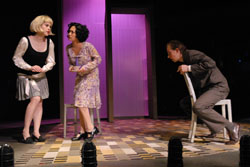I think, therefore...what?
-
-
slice.mit.edu
Filed Under
Recommended
 Professor Patrick Henry Winston ’65, SM ’67, PhD ’70
Professor Patrick Henry Winston ’65, SM ’67, PhD ’70Dramashop just performed R.U.R, Rossum's Universal Robots, which helps us understand what it will be like when the robots take over, and pretty much wipe out us humans, which I suppose serves us right, inasmuch as we have proved so proficient at wiping out other species and each other.
One night, I was asked to comment on the play afterward, because AI is my field. It took quite a while to think up three minutes of content, because it had to build to a reasonably good joke at the end.
Rossum's robots are smart and look like people, which is convenient, because they are played by human actors.
The play invites speculation on whether we humans could ever build smart robots that look like people. My answer is yes, because arguments to the contrary mostly boil down to the unthinkability fallacy: “I cannot think how that could be done; therefore, it can't be done.” Also, the biologists are doing pretty well on their side of the table, what with artificial organs and the like, and we computationally oriented types are making progress, too.
Of course, when we get close to really building such creatures, we better do a lot of simulation, because, as the play teaches, the unintended consequences of a mistake could be horrible beyond description.
In a fit of neosolipsism, it occurred to me that I and my environment might be just a simulation experiment, run by some cautious computer scientist in the sky, with a particularly twisted mind, trying out a few ideas before going physical. I don't know how I could ever tell. That Pascal idea—I think, therefore I am—doesn't seem to help.
If I am a simulation, let the record show that I resent it. And judging by the stuff I read in the papers, the experiment doesn't seem to be going too well.
Such is the wild speculation encouraged by an MIT-filled audience, a late night, and a superbly done play.







